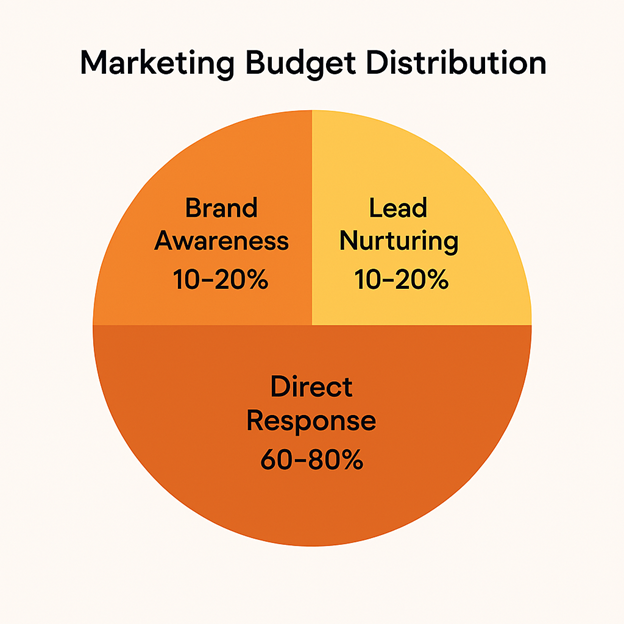Make every marketing dollar count by learning how to prioritize your marketing budget for better return on investment (ROI), faster growth, and improved sales results at every stage of business. Read on for practical advice tailored for small businesses and startups.
If you are reading this, you have probably already set aside a marketing budget, and now you are wondering how to get the most from it. But if you are still working out how much to spend, start with our post on How Much Should Your Business Spend on a Marketing Budget?. It walks through how to set a budget based on your business goals and revenue.
Assuming your marketing budget is in place, the more significant challenge is figuring out how to spend it wisely.
 Many small businesses don’t fail to get a good marketing ROI because they spend too little, but because they spend without a clear plan. They invest in the wrong channels, at the wrong time, or in the wrong order.
Many small businesses don’t fail to get a good marketing ROI because they spend too little, but because they spend without a clear plan. They invest in the wrong channels, at the wrong time, or in the wrong order.
A smart allocation strategy makes all the difference between wasted dollars and meaningful growth.
“Most marketing budgets fail to produce cost-effective and meaningful results without a solid plan.”
In this post, we will show you how to prioritize your marketing budget based on your current business stage so you can invest with confidence and see real results. Whether you are laying the groundwork, trying to grow fast, or nurturing existing leads, you will learn where to focus your spending and why it matters.

Start with a Framework, Then Adapt It
 Before we dive into custom strategies based on your business stage, it helps to understand the standard approach many larger companies use as a starting point.
Before we dive into custom strategies based on your business stage, it helps to understand the standard approach many larger companies use as a starting point.
“Spending money is easy. Spending it strategically is what drives growth.”
Salesforce, for example, recommends this basic marketing budget breakdown:
- 10–20% for brand awareness – Building visibility over time through branded content, SEO, PR, and social media.
- 10–20% for lead nurturing – Converting interested prospects into paying customers using tools like email marketing or retargeting.
- 60–80% for direct response – Driving immediate action through trackable campaigns like paid search, social ads, and limited-time offers.

This model works well for businesses that already have a strong brand, a working website, and active lead channels in place. But most small businesses—especially startups or local retailers and service providers—aren’t starting from there.
Your real marketing budget needs to reflect your current situation, including:
- What’s already in place (e.g., a well-designed website, branding, CRM)
- What type of business you run (B2B vs. B2C, service vs. product)
- Your near-term business goals (growth, visibility, retention)
In other words, don’t force your business to fit a fixed formula like the one above. Instead, use this framework as a flexible tool that you can adapt based on what your business needs right now.
Below are the priorities we recommend you apply when deciding how to allocate your marketing budget.

Priority 1: Build a Foundation (Best for Startups and Relaunches)
 If you are just getting started—or restarting after a long gap—your initial priority is getting the basics right. Without a solid foundation, even the best marketing campaigns will fall flat.
If you are just getting started—or restarting after a long gap—your initial priority is getting the basics right. Without a solid foundation, even the best marketing campaigns will fall flat.
“Don’t pour traffic into a leaky bucket—fix the foundation first.”
Suggested budget allocation: 30–50%
Focus your early marketing spend on:
- Branding and messaging – Invest just enough to look polished and professional. That might mean a logo, color palette, tagline, and consistent voice across your materials.
- Website – Your website is often the first impression potential customers will have. Make sure it’s mobile-friendly, fast, easy to navigate, and clearly explains what you offer. Add calls to action and make it easy to get in touch or buy.
- Online listings – Claim and optimize your Google Business Profile, Yelp, Bing Places, and other directories relevant to your industry.
- Social presence – Choose one or two platforms where your audience is active. Post consistently, even if it’s just a few times a week to start.
- Email list building – Start collecting emails right away. Use a signup form on your website and offer a lead magnet or simple incentive if possible.
Why it matters:
Without these pieces in place, you risk wasting money by driving potential customers to an online presence that doesn’t convert into sales. Build trust first, then scale.

Priority 2: Accelerate Growth with Direct Response Marketing
Once your foundation is in place, shift focus to bringing in new business with direct response channels that drive measurable results. It is here where most small businesses start to see a return on their marketing investment.
“Ready to scale? Direct response marketing delivers ROI fast.”
Suggested budget allocation: 40–60%
Direct response tactics to consider:
- Search engine marketing (SEM) – Appear at the top of Google when people search for products or services like yours. Paid search is highly targeted and intent-driven. Check out my blog post on Why SEO and SEM Are Essential to Growing Your Business Online.
- Paid social advertising – Reach new audiences and drive traffic through platforms like Facebook, Instagram, or LinkedIn. These campaigns work well for awareness and lead generation. Leveraging social advertising is effective for consumer-oriented brands and B2B businesses.
- Retargeting – Show ads to people who have already visited your website. Retargeting your advertising keeps your brand on top of your potential customers’ minds and increases conversions.
- Display and video ads – Expand your reach through visually engaging formats. These can support both awareness and direct conversions, depending on how they’re structured.
- Offline marketing – Depending on your industry, don’t overlook print ads, direct mail, flyers, or events. These can still deliver solid results when targeted correctly.
Pro tip:
Start small. Set a clear goal for each campaign—whether it’s leads, purchases, or signups—and measure performance. Reinvest in what’s working. Cut or adjust what’s not.

Priority 3: Nurture Leads and Build Loyalty
It is easier and more cost-effective to sell to someone who already knows you than to win over a stranger. That is why lead nurturing and customer retention deserve a spot in every marketing budget, even if they do not initially seem urgent.
“Most businesses don’t need more leads—they need better follow-up.“
Suggested budget allocation: 10–20%
Use this portion of your budget to:
- Send drip email campaigns – Stay in touch with leads over time using drip email marketing. Share helpful content, product info, or success stories to build trust and guide them toward a purchase.
- Launch loyalty or referral programs – Reward repeat customers and encourage them to spread the word. Even simple incentives can drive powerful results.
- Run subscriber-only sales or promotions – Give your email list or social followers early access to offers. Targeted loyalty promotions will make them feel valued and keep them engaged.
- Publish newsletters with value – A good newsletter does more than promote. Share tips, updates, or behind-the-scenes content your audience actually wants to read.
Why it matters:
A loyal customer is more likely to buy again and refer others. Retention strategies lower your cost per sale and make every lead more valuable over time.

Bonus Tip – Always Track and Test
 Even the best allocation plan won’t work if you can’t see what’s actually delivering results. Tracking and testing are how you turn spending into strategy.
Even the best allocation plan won’t work if you can’t see what’s actually delivering results. Tracking and testing are how you turn spending into strategy.
“The best marketing budget is a flexible and adaptable one.”
Here’s how to keep your marketing spend working smarter:
- Use basic tools to monitor performance – Google Analytics, social ad dashboards, and email marketing reports all give insight into what’s working.
- Set clear goals for each campaign – Know what success looks like. Whether it’s web traffic, form submissions, or online purchases, track it.
- Test and improve over time – Try different messages, visuals, audiences, or offers. Small tweaks can lead to better results with the same budget.
Why this matters:
Even a limited budget can go further when you pay attention to the numbers. Testing helps you stop guessing and start optimizing.
FAQ – Common Marketing Budget Questions
How much of my revenue should go to marketing?
Most small businesses allocate 5–12% of gross revenue to marketing. If you are in growth mode or launching something new, you may need to invest more—especially early on. Our post on how much to spend on a marketing budget offers a more detailed breakdown.
What if I only have a tiny marketing budget?
Focus on the foundation first. Use free tools like Google Business Profile, organic social media, and email list building to create a strong base. Then, layer in paid campaigns when possible.
Is brand awareness really worth it for small businesses?
Yes, but only after your core assets are in place. It pays off in the long run, but if you are early-stage, prioritize direct response to drive revenue first.
How do I know if my marketing is working?
Track simple KPIs like website visits, cost per lead, or email open rates. If your numbers are going up and leading to actual sales, your marketing is on the right track. See How to Use Analytics to Elevate Your Content Strategy for some practical advice.
Need Help Planning Your Marketing Budget?
Marketing success is not about how much you spend. It is about how you spend it.
Whether you are just getting started or ready to scale, your budget should reflect your goals, your growth stage, and your real-world priorities. With the right plan, even a modest budget can deliver strong results. And we are here if you would like a second set of eyes on your strategy.
If you are unsure where to start—or whether your current spend is working—let’s talk. We can help you build a practical, right-sized strategy that fits your goals and your stage of business.
📬 Join our newsletter in the footer below for more small-business marketing insights.
📞 Contact us for a free, no-obligation consultation.
